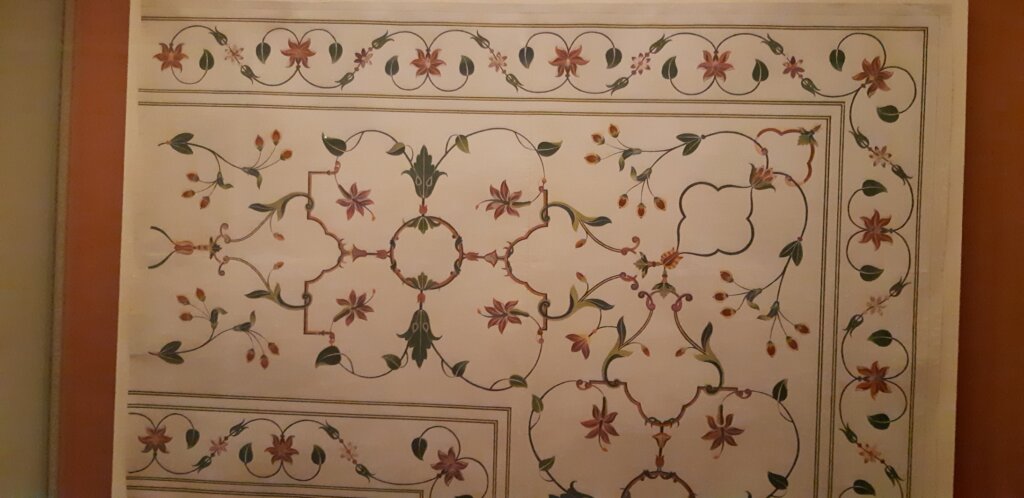When we were in India last month, we kept seeing signs in the various historical sites we visited suggesting that a lot of good stuff had been taken by the British in the 19th century and was now tucked away in various London museums. Back home, we decided to go to one of these London museums and see what we could find.
The Victoria and Albert Museum (V&A to its many friends) has a collection celebrating the arts of South Asia (that’s India, Pakistan, and Bangladesh) which it claims is “recognised as one of the largest and most important in the world”.
The amount of material on display is limited, but it is very beautiful. According to Wikipedia, the V&A is “the world’s largest museum of applied arts, decorative arts and design”, so I suppose I should not have been surprised at that beauty seems to be the main consideration in organising the display.

It looks very pretty but this assemblage of objects lacks any coherence
The V&A claims that their collection reflects “the rich heritage of South Asia and its complex history of global trade, immigration and colonial rule”. Sadly, I could see little evidence of this. For example, there are some illustrations from the 16th century Akbarnama, a volume commissioned by Akbar, arguably the greatest of the Mughal emperors, to celebrate his rule. The sumptuous pictures are shown without any of the text.

Akbar Receiving an Ambassador
In fairness to the V&A, they were probably removed from the book when it was “acquired” by the Commissioner of Oudh in 1859-62. I did like that “acquired”. The annexation of Oudh (or Avadh, as the pesky Indians of the time called it) was one of the precipitating factors in the Indian Mutiny. The Commissioner’s acquisition might reasonably be described as “loot”. The V&A rather shies away from that detail. To add insult to injury, one of the five pages on display is in a completely separate display case where, presumably, the curators felt that it looked prettier alongside other pictures rather than sitting with the other four where it logically belongs.
There are some important examples of Indian culture, like this picture of details of the decoration inside the Taj Mahal – all the more interesting because it shows parts of the upper galleries which are not visible to the public. Even here, though, the detail sits alone unsupported by even a photograph of the famous tomb. There is an example of how gemstones are fitted into marble – a key element of the Taj’s decoration – but, again, this is in a separate display with nothing linking the two.

Drawing showing detail of decoration in the Taj Mahal

A photograph I took at the Taj Mahal.
A significant amount of the display space isn’t even, strictly speaking, Indian art. Presumably it is the V&A’s interest in the “complex history of global trade, immigration and colonial rule” that accounts for so many items that have been made specifically for the export trade, like the Fremlin carpet, made around 1640 and incorporating the coats of arms of William Fremlin, an official of the East India Company. The label tells me that it would have been used as a table covering in England, rather than being put on the floor, which is interesting but tells us nothing about how carpets were used in India. (Hung on walls and used as curtains as well as, presumably, on the floor, since you ask.)

The Fremlin carpet
Outside the main room is a corridor where Hindu, Jain, Muslim and pagan religious images again make an attractive display. Time periods, geographical location, and faiths all mingle in Victorian confusion. They’re lovely to look at but tell you little about the cultures that gave rise to them.
I’ve never been a great believer in returning items to the countries they came from, but looking at this distinctively colonial approach to display here, I think of all those notices about Indian artefacts that vanished to England and I wonder if I should change my mind.
What do you think?
A Word from our Sponsor

After most of a lifetime of wanting to visit India, I’m happy to write about it for ages. But the reason for posting these pieces on my blog is to encourage people to read my book, Cawnpore, set during the Indian Mutiny/War of Independence of 1857. People who’ve read it have been very nice about it, but not nearly enough people have read it. I have kept the Kindle price at just £3.99 so as to make it easily affordable. Buy it and let me know what you think.
Here’s the LINK.

The annexation of Awadh was in 1856 when Outram was Commissioner. The Commissioner after was Coverley Jackson briefly followed by Henry Lawrence, Banks and Outram again in 1857, Montgomery in 1858, Wingfield in 1859, Barrow in 1861 and Yule followed in 1865. So which Commissioner acquired what? The sign is vague at best. Do I think things should be returned? No.